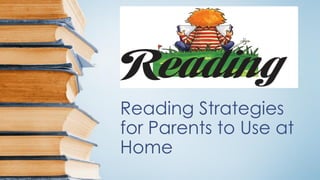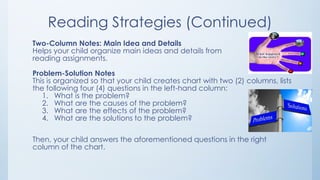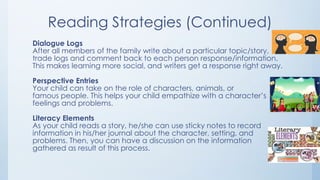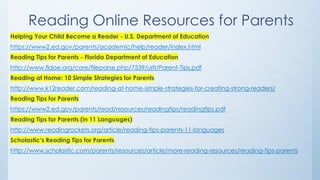Reading-Strategies-for-Parents-to-Use-at-Home.pdf
- 1. Reading Strategies for Parents to Use at Home
- 2. Rule Number One (1) Read, read, read and read some more with your child EVERY DAY!
- 3. Reading Strategies Read from Day One Start a reading routine in those very first days with a newborn. Share Books Every Day Read with your child every day, even after heshe becomes an independent reader. Visit The Library Early and Often Public libraries are great resources for books, helpful advice about authors and illustrators, story times, and more. Make visiting the library part of your family's routine.
- 4. Reading Strategies (Continued) Jump-In Reading Enjoy reading a story with family members by allowing each person to read a portion of the story. This technique motivates your child to read a longer text. Selective Underlining/Highlighting Helps your child understands the storyŌĆÖs main idea and for organizing information from selections. Think-Pair-Share Discussion strategy that helps ensure every member of the family becomes an active participant. It works well as a problem-solving strategy or as a break in a lecture.
- 5. Reading Strategies (Continued) Sticky-Note Discussions This works effectively after your child has read a selection, he/she uses sticky notes to mark the places he/she wants to talk about. Read-and-Say-Something This works effectively for difficult materials. Rather than having your child struggles alone with the meaning, have a discussion about the information contained in the text. Authentic Questions Ask your child to read or listen, record questions about the material he/she does not understand.
- 6. Reading Strategies (Continued) Seed Discussions Helps your child lead his/her own discussion by writing down one important thing about what he/she is reading. Know-Want to Know-Learned: (KWL) It involves three overlapping events: your child brainstorms what he/she knows about a topic of discussion or story, records what he/she wants to know, and then list what he/she actually learned. Pre and Post-Reading Journal Entries Your child writes about what he/she knows before reading and then writes what he/she learned from his/her reading.
- 7. Reading Strategies (Continued) Two-Column Notes: Main Idea and Details Helps your child organize main ideas and details from reading assignments. Problem-Solution Notes This is organized so that your child creates chart with two (2) columns, lists the following four (4) questions in the left-hand column: 1. What is the problem? 2. What are the causes of the problem? 3. What are the effects of the problem? 4. What are the solutions to the problem? Then, your child answers the aforementioned questions in the right column of the chart.
- 8. Reading Strategies (Continued) Dialogue Logs After all members of the family write about a particular topic/story, trade logs and comment back to each person response/information. This makes learning more social, and writers get a response right away. Perspective Entries Your child can take on the role of characters, animals, or famous people. This helps your child empathize with a characterŌĆÖs feelings and problems. Literacy Elements As your child reads a story, he/she can use sticky notes to record information in his/her journal about the character, setting, and problems. Then, you can have a discussion on the information gathered as result of this process.
- 9. Reading Online Resources for Parents Helping Your Child Become a Reader - U.S. Department of Education https://www2.ed.gov/parents/academic/help/reader/index.html Reading Tips for Parents - Florida Department of Education http://www.fldoe.org/core/fileparse.php/7539/urlt/Parent-Tips.pdf Reading at Home: 10 Simple Strategies for Parents http://www.k12reader.com/reading-at-home-simple-strategies-for-creating-strong-readers/ Reading Tips for Parents https://www2.ed.gov/parents/read/resources/readingtips/readingtips.pdf Reading Tips for Parents (in 11 Languages) http://www.readingrockets.org/article/reading-tips-parents-11-languages ScholasticŌĆÖs Reading Tips for Parents http://www.scholastic.com/parents/resources/article/more-reading-resources/reading-tips-parents
- 10. Reading Online Resources for Parents (Continued) Reading Tips for Parents - Florida Department of Education http://www.fldoe.org/core/fileparse.php/7539/urlt/Parent-Tips.pdf Strategies Packet for Parents and Students for Improving Reading, Writing and Mathematics https://reports05.nwea.org/nwea/help/DRS_Inst_Strat.pdf Reading Tips for Parents of Middle School Students http://www.nhcs.net/trask/Documents/Reading%20Tips%20for%20Parents.pdf Tips for Helping Children with Reading Comprehension Difficulties https://www.superduperinc.com/handouts/pdf/136_Reading_Comprehension_Difficulties.pdf Reading Comprehension Tips for Parents https://www.bloom-carroll.k12.oh.us/pdf/reading-comprehension-tips-for-parents.pdf A ParentŌĆÖs Little Guide to Helping Children Read http://www.springboard.org.uk/data/files/Parents/parents-little-guide.pdf









